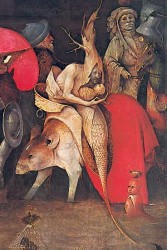
Dresen-Coenders 1977
“De strijd om de broek. De verhouding man/vrouw in het begin van de moderne tijd (1450-1630)” (Lène Dresen-Coenders) 1977
[in: De Revisor, vol. 4, n° 6 (December 1977), pp. 29-37]
[Not mentioned in Gibson 1983]
In this article Dresen-Coenders deals with the ‘women’s wiles’ motif which appears in the visual arts from the second half of the fifteenth century on and has to be related to the growing fear of women’s power. She points out that some lost Bosch paintings also dealt with this matter: the history of Abigail and the history of Betsabe could be seen on the wings of a triptych on the main altar in the ’s-Hertogenbosch church of St. John. For the chapel of St. Michael Bosch painted the histories of Esther and Judith. ‘A profusion of women’s power, no doubt painted by order of patrons’ [p. 35]. In all these cases Bosch painted women who are using their power in a good way. Dangerous, seductive women acting as instruments of the devil can be seen in the many paintings by Bosch about the temptations of St. Anthony.
It seems probable that the disreputable Malleus Maleficarum (1486) was the subject matter of sermons and discussions in ’s-Hertogenbosch in the times of Hieronymus Bosch. One of the authors, the Dominican and inquisitorial monk Jacob Sprenger, had ties with ’s-Hertogenbosch: the city fell under his jurisdiction (the Dominican province Teutonia) and the reform of the local Dominican monastery was carried out under his leadership. The Malleus abundantly joins in with the whining about the power of women and the untouchable hermit St. Anthony is mentioned several times. ‘This does not necessarily mean that the Malleus was a main source of inspiration for Bosch and his patrons. But it could have a lot of influence, because it was the subject matter of sermons…’ [p. 36]. Bosch put the delusions about witches in perspective, though, because his diabolical figures also take to task the abuses of men, especially when they have secular or ecclesiastical power.
Further it is striking how often Bosch’s diabolical figures are completely or partially based on imperfect animals (mice, reptiles). One of the issues the Malleus dwells upon, is whether witches can turn a person into an animal and in this context it distinguishes between perfect and imperfect animals. According to the Malleus devils were able to create new imperfect animals and mixed creatures using the seed of imperfect animals, whereas they were not able to actually change perfect animals (man being one of these). Whenever this does happen, it is because the devil is able to influence human perception.
With Bosch the clearest traces of delusions about witches can be found in his paintings about St. Anthony. In virtually every diabolical group on the central panel and right wing of the Lisbon triptych old women play a leading part. But here again the diabolical figures are not only associated with women: on the right wing for instance they are more often shown in combination with men. ‘It is tempting to conclude from these and other similar panels that Bosch and his patrons were aware of the changing mentality which produced delusions about witches, but that they did not surrender unconditionally to the extreme hatred of women as propagated by the Malleus Maleficarum’ [p. 37].
[explicit]